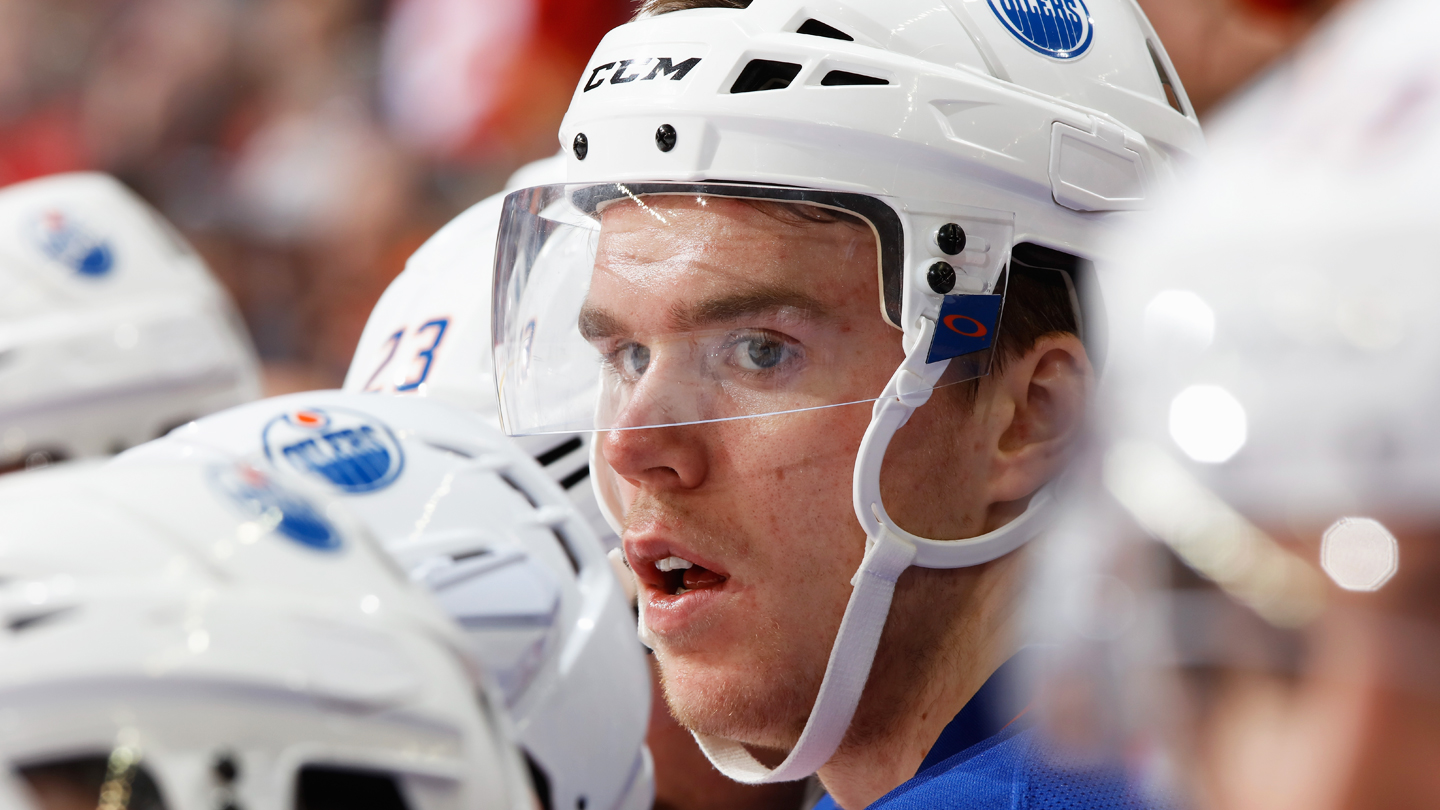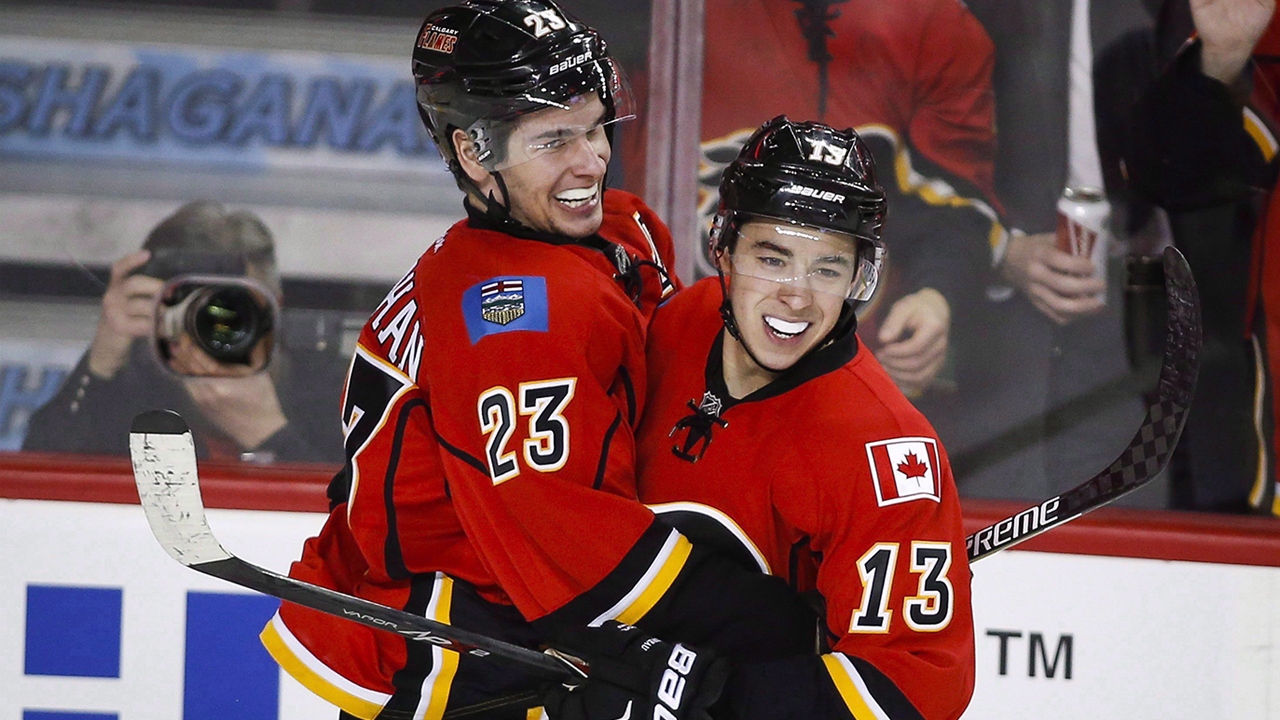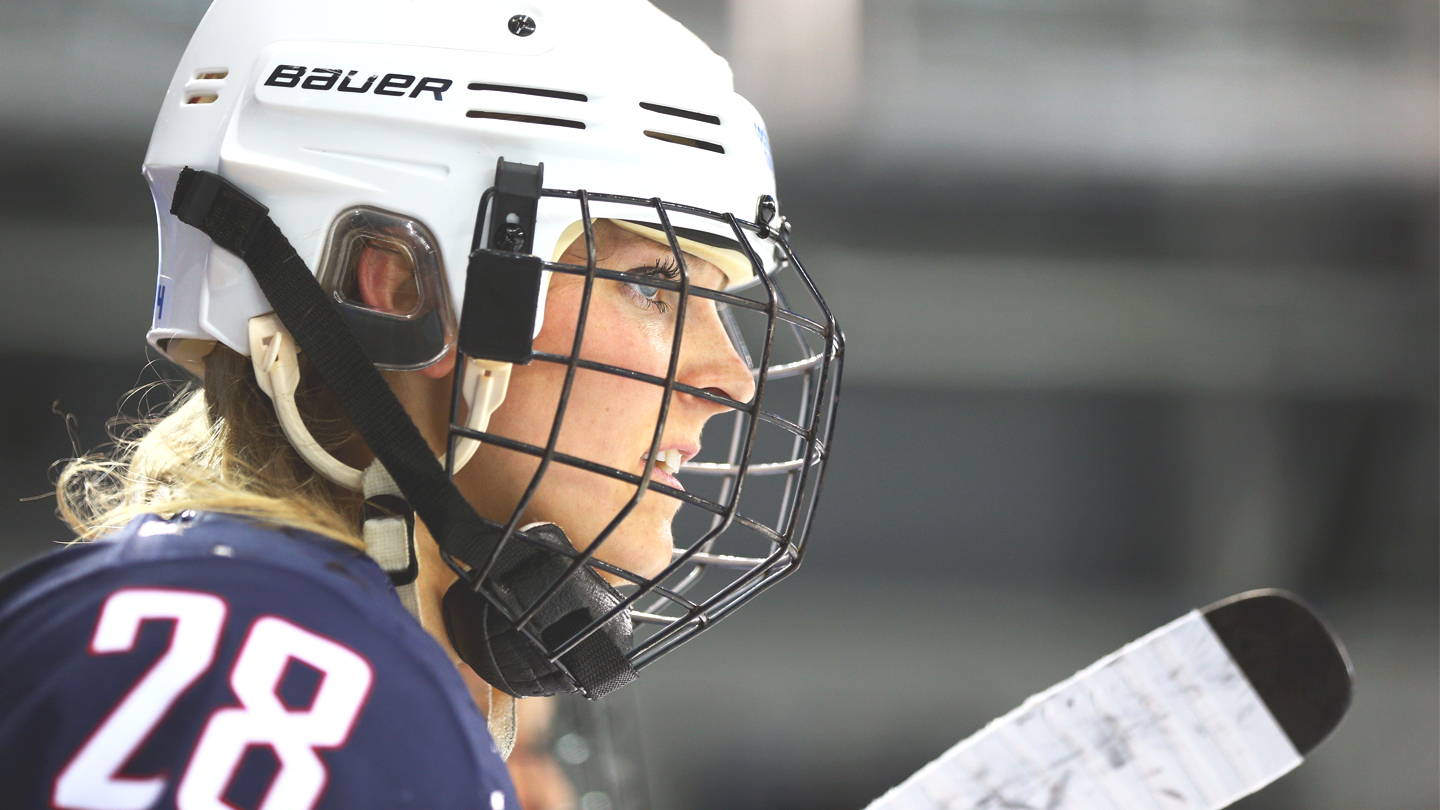Just across 104th Avenue from Rogers Place, the Edmonton Oilers’ fancy new home, construction is underway on a Marriott hotel. Despite the early stage of the project, specks of rust dot the bones of the building. The orange that really pops, though, is a crudely painted message on one of the beams. Sandwiched between two recognizable drops, it reads, “Go Oilers Go.”
That is definitely the sentiment around Northern Alberta as Connor McDavid and the Oilers head toward the 2017 playoffs. When the San Jose Sharks visit on the last Thursday of March, talk around the Oilers has gone from merely clinching a post-season berth — which the club did 48 hours prior — to winning the division. The savvy Sharks, though, soon have Edmonton on the back foot, taking a 1-0 lead and dominating the first 10 minutes of the game.
Then McDavid and his linemates find a tiny fissure to explode.
Right winger Leon Draisaitl barely has the offensive blue line when he pulls up and sends a pass through the zone to McDavid at the top of the opposite circle. In what seems to be a single elongated motion, McDavid flexes toward the high slot, jukes back outside and sweeps a pass around Sharks defenceman Justin Braun. There to receive it on the edge of the crease is Patrick Maroon, who charged the net the second he saw Draisaitl release the puck.
After one-timing home his 26th goal of the season, Maroon glides backwards into the glass. When McDavid arrives to meet him, the centre gets his face so close to Maroon’s that slipping the game sheet between their visors would be tough. McDavid then grabs either side of his teammate’s head and jolts Maroon’s helmet up until the chin strap catches to prevent any further lift. In another context, it could look like a dressing down, not a pumping up.
“That was a big goal for our team,” says McDavid, in light spirits after the eighth Oilers victory in nine outings. “I wanted to make sure he was awake and showed a bit more of a pulse than he did.”

Playing hockey has almost certainly never been more invigorating for McDavid than it is right now, as the second-year pro leads Edmonton into its first springtime appearance since 2006. And, the odd subdued celebration notwithstanding, there’s no doubt both Maroon and Draisaitl are having a blast flanking the game’s most jaw-dropping offensive talent. While some question the credentials of people who benefit from their proximity to genius, the fact is Maroon and Draisaitl—the former a longshot-turned-finisher, the latter always projected to be a star — each bring unique attributes that have helped them mesh with their centre. The result is McDavid finding himself at the epicenter of a trio that’s nearly impossible to stop — and by extension, in the middle of a city simmering with hope.
After the Oilers’ punched their playoff ticket with a 2-1 win over the L.A. Kings on March 28, McDavid was hit with a familiar late-season question: “Did the intensity out there tonight have the feel of a playoff game?” The reply was so plainly factual it had to be a bit funny: “People keep asking me that; I’ve never played in the playoffs, so I can’t really say what that’s like.”
For an outsider, a sense of humour isn’t something you necessarily expect from a 20-year-old whose public persona doesn’t usually remind people of Louis CK. But if anyone on the team is best positioned to see all dimensions of McDavid’s personality, it’s Draisaitl. The Oilers’ two youngest regulars — Draisaitl turned 21 early in the season — and top scorers share a real bond. Whether it’s going out for lunch after practice or just hanging around, McDavid and Draisaitl have clicked right from the give-and-go. “I’m very close with Leon,” McDavid says of his dressing room neighbour. “We’re great buds off the ice and I think that can translate on the ice.”
The chemistry isn’t hard to spot. The first goal in Edmonton’s victory over Los Angeles came courtesy of McDavid, when his attempt at a pass to Maroon on a 2-on-1 caromed off Kings defenceman Derek Forbort and into the net. That part of the rush may have included a lucky bounce, but the play started when the left-shooting Draisaitl — positioned on his off wing — made a delicate chip inside his own blue line, allowing the puck to be hoovered by McDavid in the neutral zone. Those effective little touches that occur a long way from the opponent’s net speak to the nuance in Draisaitl’s game.
“He’s a very shaped, all-around player,” says Kings captain Anze Kopitar, who played with Draisaitl on Team Europe at the World Cup last September. “He can score goals, he can make plays, he’s solid defensively; he’s strong on the puck in general, that’s why he can make all those plays.”
That combination of obvious skill with less-glamourous abilities — conveniently packaged in a six-foot-one, 216-lb. body — is what got Draisaitl drafted third overall in 2014 after his second season in the Western Hockey League. The following year, Draisaitl started with Edmonton, producing just two goals in 37 games before returning to the WHL. Last season, Draisaitl kicked off the campaign with a handful of American League contests before becoming an Oiler for good. Now a third-year NHLer, he produced 77 points in 82 games, reminding any team guilty of tunnel vision that Edmonton is about more than No. 97. “Everyone’s so focused on Connor, they always forget about Leon,” says Maroon.
Oilers coach Todd McLellan says there’s appreciable growth in Draisaitl’s game on a few fronts. Place him on about 25 other teams in the league and Draisaitl would be the lead young stud. Instead, he’s playing with a guy who just won his first scoring championship as a sophomore and figures to keep stacking them up like hay bales in a Prairie barn. McDavid-level greatness can have any number of positive effects on people, but — and McLellan has seen this before — it can also foster deferential tendencies. “You automatically take the second seat to him,” the bench boss explains.

The key to avoiding that, McLellan notes, is understanding the role of top gun can be auditioned for every single night, whether it’s Draisaitl or other high-end players like Jordan Eberle and Ryan Nugent-Hopkins challenging McDavid. “Guys can fight for that right or that position,” McLellan says. “There’s nothing wrong with internal competition. Even being on the same line, [McDavid and Draisaitl] push each other. Those two players are close, they care about each other. For as much as Connor plays, he’s pulling Leon along and Leon’s pushing Connor.”
With all due respect to Maroon, he’s not quite a nightly figure in the “best player on the ice” conversation. That said, the 28-year-old has fit perfectly alongside McDavid and his success this year — Maroon scored 27 goals in 81 outings, more than doubling his previous career high of 12 — goes well beyond right place, right time.
The Oilers acquired Maroon for low-grade prospect Martin Gernat and a fourth-round pick from the Anaheim Ducks at last year’s trade deadline. The deal drew virtually no attention outside Alberta because Edmonton was in its customary irrelevant place in the standings, while Maroon was a player who, aside from a great run in the 2015 playoffs beside Ryan Getzlaf and Corey Perry, didn’t really register with a wider audience. The knock within hockey circles had long been that Maroon — a sixth-round choice of the Philadelphia Flyers in 2007 — couldn’t skate a lick, one of the most damning critiques you can lob at someone in today’s go-go NHL.
But the six-foot-three, 227-lb. left winger found an immediate connection with McDavid upon landing in Edmonton, finishing with eight goals in 16 outings as an Oiler. It didn’t take long for McDavid to realize Maroon, who has hammered away at his skating, had game. “He was very underrated when he got here,” says McDavid. “I don’t think he got traded for very much — they practically gave him away — and it’s a credit to [Oilers GM Peter Chiarelli] and the management staff for recognizing his skill and bringing him on. I think a lot of people might have looked at it and wondered why, but he’s proved everyone wrong. He’s so smart on the ice, so big, gets up and down the ice pretty well, his hands are great; he’s got a lot of attributes that are tough to find.”

It’s also worth noting that, even with McDavid’s transcendent abilities, the connection Maroon and Draisaitl share with their centre isn’t assured. Milan Lucic signed a seven-year, $42-million contract to be part of the Oilers resurgence last summer and was earmarked for spot as first-line left winger beside the jewel of the organization. Both Lucic and Eberle spent significant time with McDavid at the start of the year, but real magic proved elusive.
In the case of Eberle, he and McDavid can be lethal in open ice. However, as a smaller player, Eberle has a tough time recapturing lost pucks on the boards and extending offensive zone time the way Maroon and Draisaitl can. While that will never be a problem for the strapping Lucic, there may be some limitations when it comes to sheer creativity. “Maroon probably has a more offensive mind than Lucic,” says a member of another team’s coaching staff.

Part of that is because Maroon, in addition to possessing pretty deft hands, always had to make up for a slow stride with a quick brain. Whatever the case, the affable American is definitely smart enough to relish the plush position he’s in now. Maroon calls playing with McDavid and Draisaitl an honour, is thankful to the coaches for sticking with him through a few rare rough patches and is committed to doing everything he can off the ice to ensure his success continues. “I want to play there,” he says of his top-line slot. “That’s one thing I really want to do is continue to play there [and] stay in this organization.”
Given the Oilers will never again have to worry about an owner selling a kissed-by-God player to settle debts, it’s fair to assume McDavid will be in orange and blue for years to come. Even if winning the Stanley Cup in his first post-season trip feels like a longshot, the excitement that spilled onto the streets in the form of honking horns and waving flags after Edmonton secured its playoff spot is fully justified. In addition to the big line, there’s reason to believe things are truly changing in the town that used to hang banners as frequently as shirts.
“Their top guys, and their forwards, want to play defence now,” says Kings defenceman Drew Doughty, who knows a few things about how to win Cups, “whereas in the past, I feel like their top guys kinda just worried about getting points. That’s the biggest [change] I see is they’re all responsible in both ends of the ice.”
And then there’s Connor, which is all anybody around the team calls him. Watch McDavid for any length of time and there are constant reminders that, like a four-year-old who turns an empty cardboard box into an entire universe, he has an astonishing ability to make something of nothing. “He’s a guy who can take over a game,” says Maroon. “It can be a one-man show. He’s scary, from the D-zone to the offensive zone, he’s really scary and he can make things happen so fast.”
And with the right kind of help, who knows what McDavid might create in the next little while.





